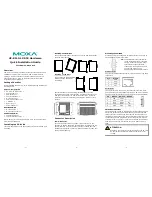
ENGLISH
44
4.6. Salt tank connection
a. Mono : Fit the end piece of the salt tank into the brine valve and check that the four corners of the salt tank are properly
fit into the bottom cladding.
b. Duo : Connect the salt tank to the body of the softener. Push the pipe into the brine connection propertly.
It should penetrate several millimeters
Vi50 Monobloc
Vi30 - Vi50 - Vi100 Duo
a.
Pressurization :
a.1. Bypass with 3 valves :
Close valves 1, 2 and 3. Open the meter valve. Valve 2 remains closed. Open
valve 1, then 3 (p 11 c.1.)
a.2. Build-in by-pass :
Set the valve to bypass position. Open the water meter. Check for leaks from hoses.
Gradually open the bypass valve and check the tightness of the assembly.
The softener is now under pressure.
Operating pressure is 2 to 6 bar. The adjustable pressure-reducing valve is preset to 3 bar.
The optimal operating pressure for the softener is between 3 and 5 bar.
b.
Fill the salt tank with water softener salt tablets.
c.
Plug the transformer into the power outlet.
d.
The softener is ready to be used. The display displays : . . 01
The softener performs a first regeneration process to remove the air and salt.
It will then switch to operating position with the time display on the screen.
e.
Run a hardness test to check the residual hardness setting.
An internal bypass, located in the inlet-outlet box to the left of the unit, equipped with an adjusting screw
is used to mix fresh water and a certain amount of hard water.
This bypass is factory pre-set to obtain a residual hardness factor of 1/5 of the inlet hardness. --> If you set
the hardness to 35°f, the water is softened to 7°f.
To change the residual hardness, tighten the adjustment screw for softer water and loosen it for harder
water. (¼ turn of the screw = approx. 1°f)
Then run a hardness test to check the setting.
Fitting a faucet to the water-softener outlet makes it easier to monitor the water hardness.
5. COMMISSIONING
6. RESIDUAL HARDNESS SETTING









































